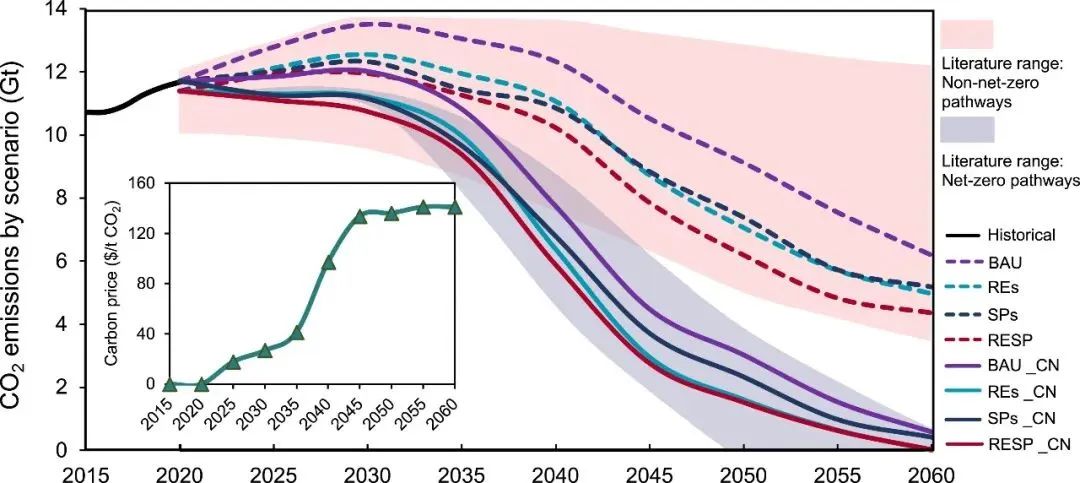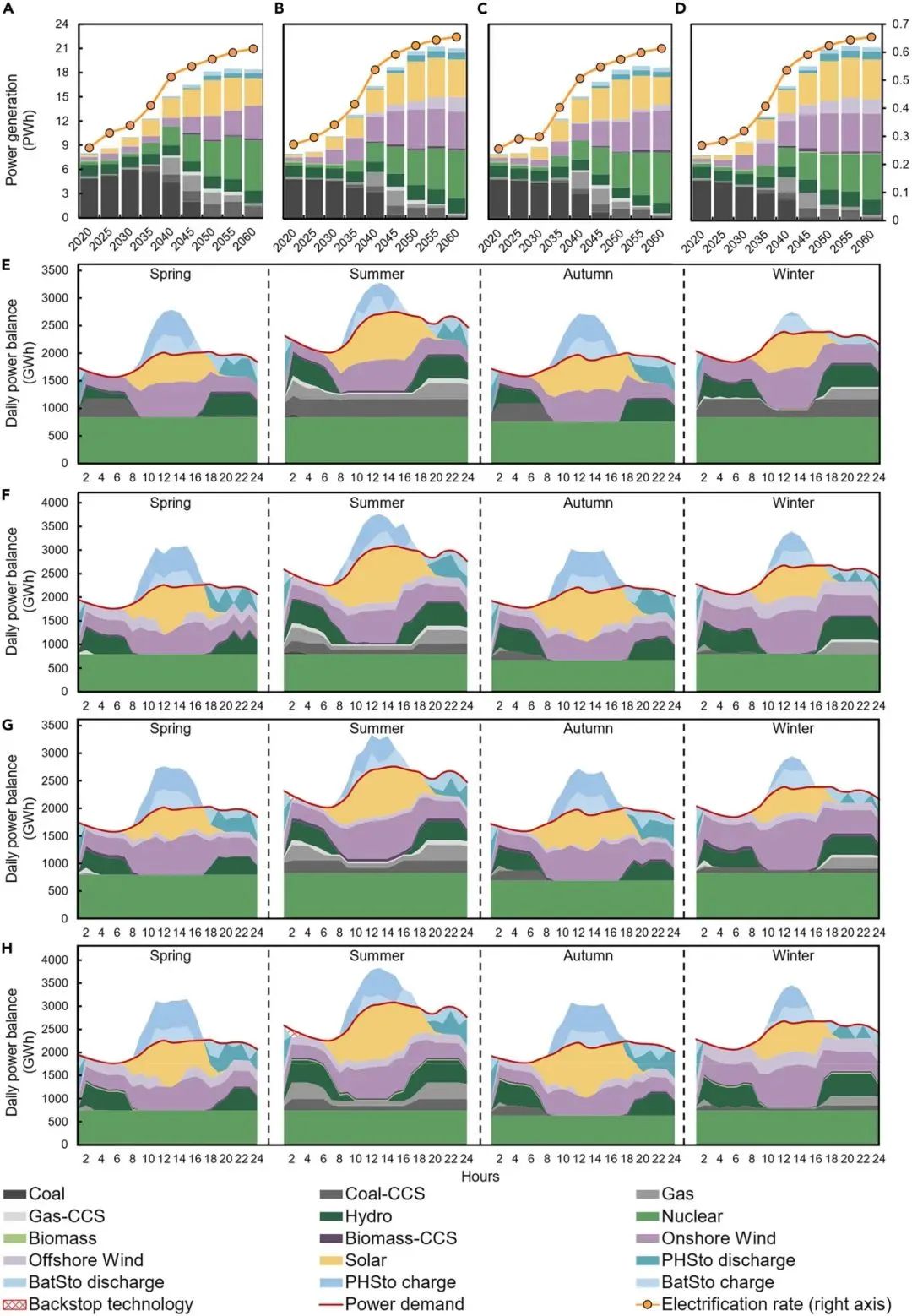A recent study by the “Carbon Neutrality and Energy System Transformation (CNEST)” multilateral cooperation project team at Tsinghua University and collaborators explored the combined effects of coal power capacity control and renewable energy expansion on China’s net-zero strategy. The research developed a coupled analytical framework based on the Global Change Assessment Model (GCAM) and a power system optimization model to quantify the emission reduction potential of strict coal capacity control and accelerated renewable deployment at the socio-economic level, while also identifying and quantifying potential risks to power system adequacy from implementing coal control policies alone at the operational level. By analyzing key transition differences between four non-net-zero scenarios and their corresponding net-zero scenarios, the study proposes tailored transition recommendations to support a smooth shift toward a net-zero energy system in China.
Stringent control of coal power capacity growth and accelerated renewable energy deployment are two critical measures for China to achieve net-zero emissions. The 2023 Sunnylands Statement between China and the U.S. affirmed a consensus on accelerating renewable deployment to replace fossil fuels. However, the energy transition under the “dual carbon” goals faces multiple challenges: the impact of immediate strict coal capacity control on a smooth energy transition remains unevaluated, and replacing coal with renewables involves systemic issues beyond supply adequacy, including emission trajectories, energy structure, and grid stability. Previous studies often emphasized the broad necessity of halting new coal projects to meet climate targets but overlooked these plants’ critical role in energy security. Compared to traditional single-model integrated assessment approaches, this study coupled a technologically detailed GCAM model, calibrated for China, with an hourly power system optimization model to capture interactions between coal and renewable power, thereby enhancing analytical precision, systematicity, and comprehensiveness.

Figure 1. Emission pathways and carbon price changes under different scenarios
Results show that under the baseline net-zero transition scenario (BAU_CN), China could achieve approximately 148 Gt CO₂ reductions (2020–2060), covering about 37% of the global carbon budget under a 1.5°C target. These reductions are primarily driven by dynamic carbon pricing that balances emission cuts across sectors. Beyond carbon pricing, stricter coal capacity control and lower renewable costs further reduce emissions. As shown in Figure 1, strict coal control (SPs_CN) yields significant short-term emission reductions, cutting an additional ~27 Gt CO₂, while lower renewable costs (REs_CN) enable greater fossil fuel substitution and long-term reductions, cutting an extra ~38 Gt CO₂. Combining both measures (RESP_CN) increases cumulative reductions to 196 Gt, covering ~49% of the global carbon budget.

Figure 2. Power mix, electrification rate, and hourly supply-demand balance under different net-zero scenarios
Restricting coal investments (SPs_CN) accelerates the decline of coal in the power mix but also reduces total power output by ~5.7% in 2025 and ~11.1% in 2030 (Figure 2), slowing end-use electrification. Reduced electrification反而 increases direct coal use in end-use sectors. Compared to electrification rates of 33.4% in BAU_CN and 33.9% in REs_CN, SPs_CN only reaches 29.6% by 2030. Although new coal projects are banned, existing coal plants must remain operational to meet rapid demand growth in 2030–2035. Thus, coal power generation in 2035 under SPs_CN is projected to be ~650 TWh higher than in REs_CN, where renewables gradually replace coal. These results indicate that immediately strict coal restrictions, while reducing coal share, may adversely affect power supply, electrification, and end-use decarbonization, highlighting the need to balance accelerated electrification with sufficient low-carbon power supply in China’s “dual carbon” transition.
Using an hourly power system optimization model, the study further revealed risks from implementing coal capacity control alone. In later stages of China’s net-zero pathway (post-2050), growing electricity demand requires high-cost backup technologies (e.g., seasonal storage) to address potential load shedding risks during high-demand summer days. Compared to BAU_CN and REs_CN, SPs_CN lacks both new coal and low-cost renewables, reducing system stability and adequacy and increasing reliance on backup technologies. By 2050, up to ~270 GW (~12% of peak load) in SPs_CN must be met by backup technologies, required for up to 7 hours per day. In RESP_CN, accelerated renewable deployment combined with storage mitigates adequacy risks from coal control, reducing dependence on high-cost backups. These findings underscore the importance of complementing coal capacity control with other clean energy deployments, such as retrofitting existing coal plants or implementing equivalent low-carbon alternatives, to balance emission reduction and energy security.
This study developed a coupled analytical framework to explore synergistic emission reduction benefits from accelerating renewable expansion and implementing strict coal capacity control, identified risks and challenges from premature and singular coal phase-out policies, and highlighted the importance of integrating low-cost renewables for long-term decarbonization and power system adequacy. These insights provide new perspectives for supporting a smooth transition to a net-zero energy system in China and offer valuable support for policy-making.
The related findings, titled “Reassessing Immediate Coal Phase-Out: Dual Imperatives of Capacity Control and Renewables Expansion in China’s Net-zero Strategy,” were published in Nexus, an interdisciplinary journal by Cell Press. The first author is Wang Jiaxing, a PhD student at the School of Environment, Tsinghua University. Corresponding authors include Professor Lu Xi from the School of Environment and the Institute for Carbon Neutrality at Tsinghua University, Professor Fan Jingli from the School of Energy and Mining Engineering at China University of Mining and Technology (Beijing), and Researcher Zhang Xian from the Administrative Center for China’s Agenda 21.
The research was supported by the Carbon Neutrality and Energy System Transformation (CNEST) Program, the National Natural Science Foundation of China, the National Key R&D Program of China, and the Ordos-Tsinghua Carbon Neutrality Innovation Cooperation Research Project.
Paper Link:
https://doi.org/10.1016/j.ynexs.2025.100081
 Latest recommendations
Latest recommendations


